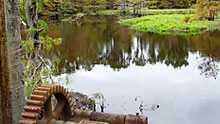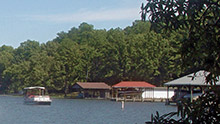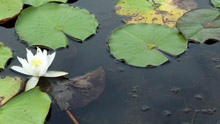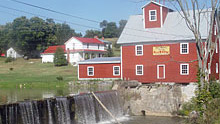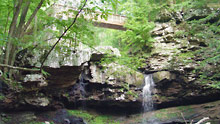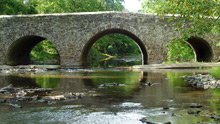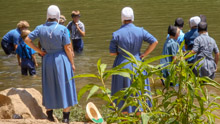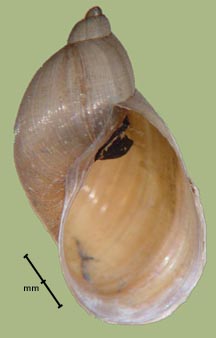> Habitat & Distribution
Lymnaea columella is widespread throughout eastern North America (Baker 1911), and has been introduced around the world (Malek & Chrosciechowski 1964). Populations are nearly ubiquitous in the eastern United States, in backwaters and lentic environments, especially at the margins of lakes, ponds, and swamps, on floating or emergent vegetation, not uncommonly above the water line. FWGNA incidence rank I-5.
Lymnaea columella is much less common in the Great Plains. We have records of just eight populations in the states of Kansas, Nebraska, South Dakota and North Dakota combined.
> Ecology & Life History
As an invader of new habitats, L. columella may rival Physa acuta and Helisoma trivolvis. Less is known about its biology, however. It has a stronger trophic apparatus than Physa, well-suited for consuming filamentous algae and macrophytes (Kesler et al. 1986).
Jokinen's (1987) analysis of the distribution of L. columella in Connecticut and New York led her to classify it as a Supertramp species, found only in the most species-poor communities. Dillon s (2000: 360-363) USR reanalysis of these data suggested that L. columella populations in Connecticut seem to be Undifferentiated with respect to life history adaptation.
Jokinen (1985) reported two generations per year in an L. columella population from Connecticut (Bis of Dillon 2000: 156-162). The lab experiments of Gutierrez and colleagues (2001) suggested that L. columella may be a preferencial self-fertilizer.
Lymnaea columella is one of many amphibious lymnaeid taxa capable of serving as an intermediate host for trematodes causing fascioliasis in livestock, and rarely humans (Mas-Coma et al. 2005).
> Taxonomy & Systematics
Burch (following Baker 1911) placed L. columella in the monotypic genus Pseudosuccinea. But many of the molecular phylogenies of the Lymnaeidae published in recent years have included individual L. columella sequences at least incidentally, and none have returned evidence of exceptional divergence (Correa et al 2010, 2011). We prefer Hubendick s (1951) simpler classification of the Lymnaeidae, however, with Pseudosuccinea a subgenus. See my essay of 28Dec06 from the link below for more, as well as the series of blog posts I entitled, "The Lymnaeidae 2012."
> Maps and Supplementary Resources
- Lymnaea distribution in drainages of The Ohio (2019)
- Lymnaea columella distribution in Atlantic drainages (2023)
- Lymnaea distribution in Georgia and the Florida panhandle (2025)
- Lymnaea distribution in the Tennessee/Cumberland (2022)
- Lymnaea distribution in The Great Plains (2024)
> Essays
- See my post to the FWGNA blog of 28Dec06 for a review of The Classification of the Lymnaeidae.
- A charming essay by Bill Hilton, Jr. of the Hilton Pond Center for Piedmont Natural History on Unexpected Freshwater Bucket Snails, featuring excellent photos of living P. columella, its shell, eggs and embryos.
- I reviewed the systematics of the worldwide Lymnaeidae in a five-part series of blog posts between April and August of 2012. Lymnaea columella was only touched incidentally, in my 4June12 review of Correra's 2011 molecular phylogeny: "The Lymnaeidae 2012: Stagnalis Yardstick."
> References
Bailey, J. L. Jr. 1931. Some data on growth, longevity, and fecundity in Lymnaea columella Say. Biologia Generalis 7: 407-428.
Baker, F. C. 1911. The Lymnaeidae of North and Middle America, Recent and Fossil. Special Publication, no. 3. Chicago: Chicago Academy of Natural Sciences. 539 pp, 55 pl.
Brown, K.M. 1982. Resource overlap and competition in pond snails: an experimental analysis. Ecology 63:412-422.
Brown, K.M. 2001. Mollusca: Gastropoda. In: J.H. Thorp and A.P. Covich, eds., Ecology and Classification of North American Freshwater Invertebrates, Academic Press, New York. Pp. 297-329.
Burch, J.B. 1989. North American Freshwater Snails. Malacological Publications, Hamburg, Michigan.
Clarke, A.H. 1979. Gastropods as indicators of trophic lake stages. Nautilus 93:138-142.
Clarke, A.H. 1981. The Freshwater Molluscs of Canada. National Museum of Natural Sciences, National Museums of Canada, Ottawa, Canada.
Correa, A. C., J. S. Escobar, P. Durand, F. Renaud, P. David, P. Jarne, J-P Pointier, & S. Hurtrez-Bousses (2010) Bridging gaps in the molecular phylogeny of the Lymnaeidae (Gastropoda: Pulmonata), vectors of Fascioliasis. BMC Evolutionary Biology 10: 381.
Correa, A. C., J. S. Escobar, O. Noya, L. E. Velasquez, C. Gonzalez-Ramirez, S. Hurtrez-Bousses, and J. P. Pointier (2011) Morphological and molecular characterization of Neotropic Lymnaeidae (Gastropoda: Lymnaeoidea), vectors of fasciolosis. Infection, Genetics and Evolution 11: 1978-1988.
DeWitt, R. M. & W. C. Sloan 1958. The innate capacity for increase in numbers in the pulmonate snail, Lymnaea columella. Trans. Amer. Micros. Soc. 77: 290-294.
Dillon, R.T., Jr. 2000. The Ecology of Freshwater Molluscs. Cambridge University Press, Cambridge, United Kingdom.
Ferrer, J. R., G. Perera, M. Yong, & O. Amador. 1989. Life tables of Fossaria cubensis and Pseudosuccinea columella, intermediate hosts of Fasciola hepatica in Cuba. J. Med. Appl. Malacology 1: 189-194.
Gutierrez, A. G. Perera, M. Yong, & L. Wong 2001. The effect of isolation on the life-history traits of Pseudosuccinea columella (Pulmonata: Lymnaeidae). Mem. Inst. Oswaldo Cruz 96: 577-581.
Hubendick, B. 1951. Recent Lymnaeidae. Their variation, morphology, taxonomy, nomenclature, and distribution. Kungl. Svenska Vetensk. Akad. Handl., 3, 1-223.
Jokinen, E.H. 1985. Comparative life history patterns within a littoral zone snail community. Verh. Int. Verein. Limnol. 22: 3292-399.
Jokinen, E. 1987. Structure of freshwater snail communities: Species-area relationships and incidence categories. Amer. Malac. Bull. 5: 9 - 19.
Jokinen, E.H. 2005. Pond molluscs of Indiana Dunes National Lakeshore: then and now. Amer Malac Bull 20:1-9.
Malek, E. & P. Chrosciechowski 1964. Lymnaea (Pseudosuccinea) columella from Venezuela nd notes on the distribution of Pseudosuccinea. Nautilus 78: 54-56.
Mas-Coma, S., M. D. Bargues, & M. A. Valero 2005. Fascioliasis and other plant-borne trematode zoonoses. Int. J. Parasit. 35: 1255-1278.
McKillop, W.B. 1985. Distribution of aquatic gastropods across the Ordovician dolomite Precambrian granite contact in southeastern Manitoba, Canada. Can J Zool 63:278-288.
Pip, E. 2000. The decline of freshwater molluscs in southern Manitoba. Can Field-Nat 114:555-560.
Remigio, E. A. 2002. Molecular phylogenetic relationships in the aquatic snail genus Lymnaea, the intermediate host of the causative agent of fascioliasis: insights from broader taxon sampling. Parasitology Reserach 88: 687-696.
Stewart, T.W., and R.T. Dillon, Jr. 2004. Species composition and geographic distribution of Virginia s freshwater gastropod fauna: a review using historical records. Amer Malac Bull 19:79-91.

